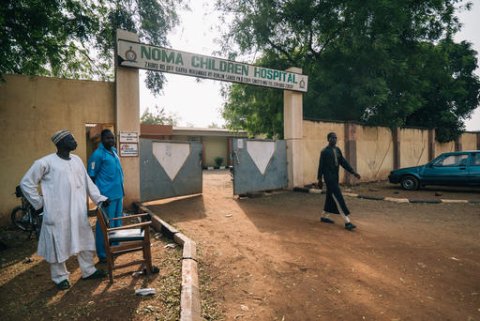“I always say noma is a wicked disease”

I always say noma is a wicked disease.
Noma or cancrum oris affects the face, eating the soft tissues and often destroying the bones completely. Sometimes it destroys the nose or even the eyes.
Mostly it affects children under the age of seven. There are many contributing factors to noma: malnutrition, a lack of vaccinations, poor oral hygiene – and ultimately poverty.
Problems set in fast
First the gum bleeds and gets inflamed. Then the soft tissue and the oral cavities are affected. The cheek starts to decay from the inside. All these problems set in fast.
Children’s cheeks become so swollen and painful. Before you know it, they just burst.
I talk to parents who have been left wondering what has happened. With most children, before the disease gets to the outer surface, it has damaged the tissues inside the mouth.
Stage 1 noma (acute necrotizing gingivitis) can be treated quite easily with antibiotics and therapeutic food. After a week in hospital, the child should be fine. But when noma reaches stage 2 (oedema) or stage 3 (gangrene), the child’s condition deteriorates quickly.
Lack of knowledge
Many parents don’t know what noma is. When they start to see the symptoms, they don’t know what to do.
Many patients come from poor communities, and from the poorest households within those communities. When the symptoms start, they don’t always have the money to travel to see a doctor.
Sometimes they believe the cause is spiritual and therefore do not seek medical care, or else they seek care from traditional healers. So when they do bring their child in, the damage is already terrible.
We cut off the damaged tissue and we dress the wounds and we continue doing this until the damage is healed. The child then has to wait anything from months to years until they are eligible for reconstructive surgery.
Trismus and malnutrition
In some cases, because of the level of damage, children get trismus, or lockjaw.
The tissues in the mouth become hard and sometimes their bones are affected too. Children with trismus can become very unwell. They struggle to eat due to the limited opening of the mouth and may become malnourished.
Children often find it hard to understand that they need to go through the pain of physiotherapy to be able to open their mouths. It is difficult seeing children with this disease. Even before I became a mother, I found it hard. But the one thing I try to do is to not let these feelings show in the presence of my patients, because it could make them lose hope.
Hardest of all is when surgeries fail, because children have gone through so many stages to get there: going to the operating theatre; experiencing painful procedures; and then not being allowed to move their heads for a few weeks, which is even more difficult for a child than for an adult.
Stories of success
But although noma is a wicked disease, we do have success stories. Sometimes a child has a cheek defect due to noma, but after surgery they begin to recover – with some patients you would not even know what caused the scars.
Other children had trismus, their mouths locked shut for years, but after trismus relief procedures, they can talk, eat and move their mouths with ease.
For me, one of the most memorable patients was a child whose nose was completely gone. That was my first time seeing nasal reconstruction. Afterwards, we went to the child’s village on a follow-up visit. When we arrived, everybody gathered around us as if they had seen God, because they realised who did this work for this boy.
Before, the boy was discriminated against in the community; he stopped going to school and people bullied him because of his condition. When he arrived back, most people didn’t recognise him. It sends a good message to the community. If a child like that can come to hospital and get that kind of beautiful reconstruction, why wouldn’t others?
To me, there is nothing more joyful than when you see a patient who came to us with facial deformities and, like magic, has had aesthetics and function restored.
A neglected disease
Before I joined MSF, I knew there was a disease called noma, but I had never seen it. It’s a neglected disease.
"Noma day" has started to create awareness, but the outside world has to know about it, because the truth is that MSF alone cannot prevent noma. We are doing our best, reaching out to people with the disease, taking care of them, helping them reintegrate into their communities. But there are thousands of patients that we have yet to reach.
Patients come to us from Nigeria’s Delta State, 1,000 km away, which shows the great need in this country for noma treatment. Right now, MSF is trying to go into preventative mode. It’s very challenging, because how do you prevent noma? One of the contributing factors is poverty. How do you alleviate poverty? Can MSF do that singlehandedly? No. That is why the world needs to join in.
Get involved
Raise awareness
Noma is a neglected disease, part of this neglect stems from the fact that noma is relatively unknown in the global health community.
In order to raise awareness about noma, we are asking people to include noma in medical teaching curricula and hold documentary screenings.
Volunteer
Each year, thousands of international staff of all nationalities carry out field assignments working with staff hired locally to give lifesaving medical assistance to people who would otherwise be denied access to healthcare, clean water and shelter.
